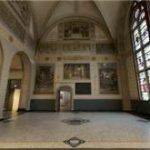|
Rijksmuseum, which houses largest collection of Dutch artwork, to reopen to public after 10-year makeover costing $480m
|
||
| The Rijksmuseum, the National Museum of the Netherlands, is finally set to reopen to the public, with Rembrandt van Rijn’s masterpiece The Night Watch reclaiming its place of pride.
The giant painting hangs in the same central position it did before a decade-long $480m makeover, flanked by works by Johannes Vermeer, Jan Steen and thousands of other Dutch cultural and artistic artifacts. In a preview on Thursday before the April 13 reopening, Wim Pijbes, Rijksmuseum director, said the far-reaching improvements will justify the long wait. “It’s totally changed, renewed, improved, radiant, everything is new,” he said. The Rijksmuseum houses the largest collection of Dutch artwork, with many treasures from the country’s 17th-century Golden Age and beyond. The 19th-century building’s red-brick exterior, which resembles a fairy-tale castle, has been restored but left intact. Inside, twin central courtyards that had been gradually filled with extra floors as the museum grew over the years have been reclaimed. The clutter has been stripped away to let natural light flood into the centre of the museum. Extreme makeover Despite reopening the courtyard, the museum preserved as much exhibition space as before by reclaiming some areas which had been used for offices. From hand-painted details on every pillar, to newly laid mosaic floors and stained glass windows, to revitalising the displays themselves, every part of the museum has been restored or rethought.
Pijbes said that almost never has a national museum undergone such a far-reaching facelift, with every single one of the 8,000 artifacts and pieces of art on display coming to rest in a different spot, with one exception: The Night Watch itself. That enormous canvas, 4.35 metre wide and 3.79 metres high, portrays a company of Amsterdam volunteer militia members. It stands at the end of the museum’s central gallery, just as it did in the original 1885 design by architect Pierre Cuypers. The painting’s placement reflects Dutch history, a crowning achievement of the Golden Age when the Netherlands was a major naval power and Amsterdam was one of the world’s most influential and wealthy cities. “The Gallery of Honour is a kind of basilica that ends not with a Christian display, but a civilian display: Rembrandt’s Night Watch,” Pijbes said. The symbolism is that “that there is no one king that has the power, that the Netherlands is a country where an early republic decided a group of people would have power in their hands”. Dutch masters The main gallery is a who’s who of Dutch masters, from landscape masters to portraitists. Highlights include Vermeer’s delicate, quiet Milkmaid (1660), in which the act of pouring milk becomes an almost religious act; as well as larger and more raucous works like Steen’s The Merry Family (1668) and Frans Hals’s The Merry Drinker (1628). And of course it includes paintings and sketches by Rembrandt, including several self-portraits and masterpieces such as one of his most-loved works, The Jewish Bride (1669), which shows a tender couple lightly touching. The museum’s head of collections Taco Dibbits said the 17th-century works will always set the museum apart from other national exhibitions. “This little country became an enormous sea power, East and West, very rich,” he said. “The old masters such as Rembrandt, Vermeer, Frans Hals, Jan Steen, they painted the world of the people, not Christ on the cross; they painted the people who made the country.” Sources:aljazeera.com |
Welcome!Log into your account

















